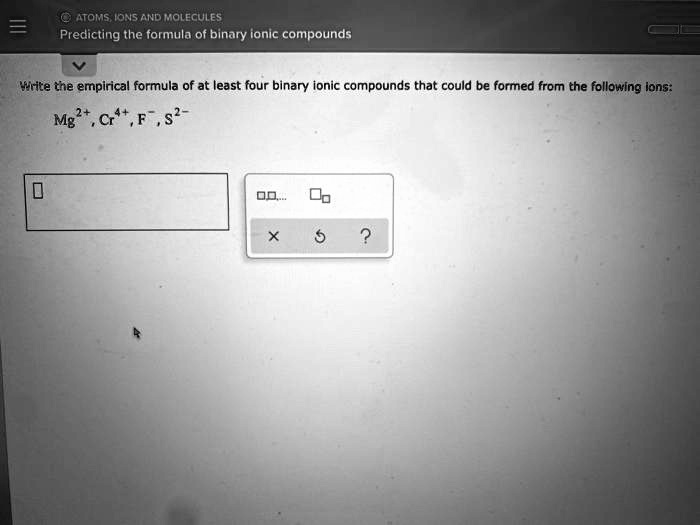ATOMS, IONS AND MOLECULES Predicting the formula of binary ionic compounds Write the empirical formula of at least four binary ionic compounds that could be formed from the following ions: Mg
, Cr
, F
, S

The Correct Answer and Explanation is:1
Here are four correct empirical formulas for binary ionic compounds that can be formed from the given ions:
- MgF₂ (Magnesium fluoride)
- MgS (Magnesium sulfide)
- CrF₄ (Chromium(IV) fluoride)
- CrS₂ (Chromium(IV) sulfide)
Explanation:
Binary ionic compounds consist of two elements, one of which is a metal that forms cations and the other a non-metal that forms anions. The goal in writing empirical formulas is to combine these ions in such a ratio that the total positive and negative charges cancel each other, resulting in a neutral compound.
- Magnesium fluoride (MgF₂): Magnesium forms a divalent cation, Mg²⁺, while fluoride forms a monovalent anion, F⁻. To balance the +2 charge from one Mg²⁺ ion, two F⁻ ions are required. The simplest whole-number ratio of ions is 1 magnesium to 2 fluorides, hence MgF₂.
- Magnesium sulfide (MgS): Sulfide ions carry a −2 charge (S²⁻). Since both Mg²⁺ and S²⁻ are doubly charged with opposite signs, a 1:1 ratio balances the charges perfectly. The empirical formula is MgS.
- Chromium(IV) fluoride (CrF₄): Chromium(IV) forms a Cr⁴⁺ ion. Fluoride is still F⁻. It takes four F⁻ ions to neutralize one Cr⁴⁺ ion. Thus, the resulting empirical formula is CrF₄.
- Chromium(IV) sulfide (CrS₂): With Cr⁴⁺ and S²⁻, two sulfide ions (each with a −2 charge) are needed to balance the +4 charge of one chromium ion. This gives a formula of CrS₂.
These compounds demonstrate the principle of charge neutrality and the importance of using subscripts in chemical formulas to reflect the correct ratio of ions. Understanding how to derive empirical formulas is fundamental in ionic chemistry and helps in predicting compound composition from known ion charges
.
